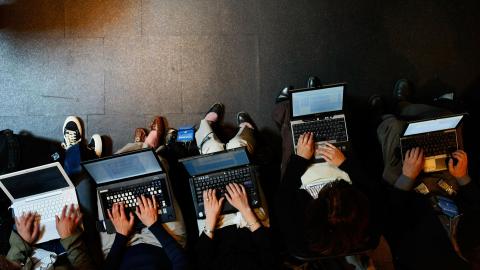Over 40% of workers are considering quitting their jobs

Mark Wilson/Getty Images
- Junior members of the workforce, including Generation Z, are facing digital burnout.
- 41 percent of workers globally are thinking about handing in their notice, according to a new Microsoft survey.
- A hybrid blend of in-person and remote work could help maintain a sense of balance – but bosses need to do more.
More than half of 18 to 25 year-olds in the workforce are considering quitting their job. And they’re not the only ones.
In a report called The Next Great Disruption Is Hybrid Work – Are We Ready?, Microsoft found that as well as 54% of Generation Z workers, 41% of the entire global workforce could be considering handing in their resignation.
Similarly, a UK and Ireland survey found that 38% of employees were planning to leave their jobs in the next six months to a year, while a US survey reported that 42% of employees would quit if their company didn’t offer remote working options long term.
New work trends
Based on surveys with over 30,000 workers in 31 countries, the Microsoft report – which is the latest in the company’s annual Work Trend Index series – pulled in data from applications including Teams, Outlook and Office 365, to gauge productivity and activity levels. It highlighted seven major trends, which show the world of work has been profoundly reshaped by the pandemic:
- Flexible work is here to stay
- Leaders are out of touch with employees and need a wake-up call
- High productivity is masking an exhausted workforce
- Gen Z is at risk and will need to be re-energized
- Shrinking networks are endangering innovation
- Authenticity will spur productivity and wellbeing
- Talent is everywhere in a hybrid world
“Over the past year, no area has undergone more rapid transformation than the way we work,” Microsoft CEO Satya Nadella says in the report. “Employee expectations are changing, and we will need to define productivity much more broadly – inclusive of collaboration, learning and wellbeing to drive career advancement for every worker, including frontline and knowledge workers, as well as for new graduates and those who are in the workforce today. All this needs to be done with flexibility in, when, where and how people work.”
Organizations have become more siloed
While the report highlights the opportunities created by increased flexible and remote working patterns, it warns that some people are experiencing digital exhaustion and that remote working could foster siloed thinking. With the shift to remote working, much of the spontaneous sharing of ideas that can take place within a workplace was lost. In its place are scheduled calls, regular catch-ups and virtual hangouts. The loss of in-person interaction means individual team members are more likely to only interact with their closest coworkers.
“At the onset of the pandemic, our analysis shows interactions with our close networks at work increased while interactions with our distant network diminished,” the report says. “This suggests that as we shifted into lockdown, we clung to our immediate teams for support and let our broader network fall to the wayside. Simply put, companies became more siloed than they were pre-pandemic.”
Burnout or drop out
One of the other consequences of the shift to remote and the reliance on tech-based communications has been the phenomenon of digital burnout. And for those who have most recently joined the workforce, this has been a significant challenge.

The excitement of joining a new employer, maybe even securing a job for the first time, usually comes with meeting lots of new people, becoming familiar with a new environment and adapting to new situations. But for many, the pandemic turned that into a daily routine of working from home while isolated from co-workers.
“Our findings have shown that for Gen Z and people just starting in their careers, this has been a very disruptive time,” says LinkedIn Senior Editor-at-Large, George Anders, quoted in the report. “It’s very hard to find their footing since they’re not experiencing the in-person onboarding, networking and training that they would have expected in a normal year.”
But it is perhaps the data around quitting that is one of the starkest indications that change is now the new normal. Being able to work remotely has opened up new possibilities for many workers, the report found. If you no longer need to be physically present in an office, your employer could, theoretically, be located anywhere. Perhaps that’s why the research found that “41% of employees are considering leaving their current employer this year”.
In addition to that, 46% of the people surveyed for the Microsoft report said they might relocate their home because of the flexibility of remote working.
A hybrid future
In looking for ways to navigate their way through all this change, employers should hold fast to one word, the report says – hybrid. An inflexible, location-centred approach to work is likely to encourage those 41% of people to leave and find somewhere more to their tastes. Those who are thinking of going to live somewhere else, while maintaining their current job, might also find themselves thinking of quitting if their plans are scuppered.

But remote working is not a panacea for all workforce ills. “We can no longer rely solely on offices to collaborate, connect, and build social capital. But physical space will still be important,” the report says. “We’re social animals and we want to get together, bounce ideas off one another, and experience the energy of in-person events. Moving forward, office space needs to bridge the physical and digital worlds to meet the unique needs of every team – and even specific roles.”
Bosses must meet challenges head on
Although the majority of business leaders have indicated they will incorporate elements of the hybrid working model, the report also found many are out of touch with workforce concerns more widely.
For, while many workers say they are struggling (Gen Z – 60%; new starters – 64%), and 54% of the general workforce feels overworked, business leaders are having a much better experience. Some 61% said they were ‘thriving’, which is in stark contrast to employees who are further down the chain of command.

Jared Spataro, corporate vice president at Microsoft 365, writes in the report: “Those impromptu encounters at the office help keep leaders honest. With remote work, there are fewer chances to ask employees, ‘Hey, how are you?’ and then pick up on important cues as they respond. But the data is clear: our people are struggling. And we need to find new ways to help them.”
Reprinted with permission of the World Economic Forum. Read the original article.





